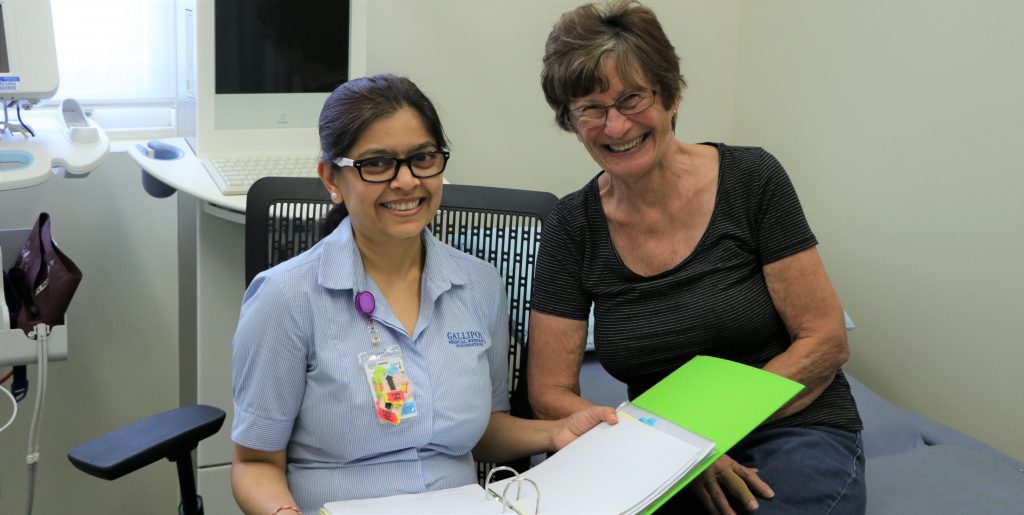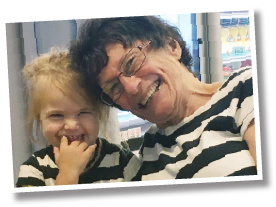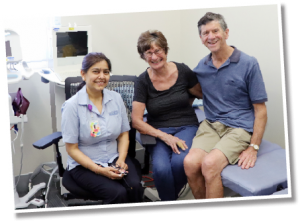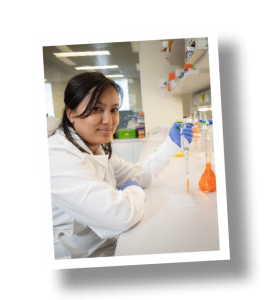
Pictured: GMRF Clinical Trial Coordinator Vaishali with Di during treatment
Haemochromatosis: Di’s Story of Hope
Up until she was 38, Di hadn’t even heard the word haemochromatosis. The first time it was explained to her was in a doctor’s room in 1983, delivered as a life-altering diagnosis.
“At the time I had four kids on my own and was working full-time as a nurse. I became really fatigued, had tummy problems and felt nauseous so I went to the GP. He looked at my skin, which had gone bronze, and immediately had the idea to test my iron levels,” Di says.
Di’s story could have taken a tragic turn here if the doctor hadn’t run those tests. Keep in mind a normal range for ferritin (iron) in the blood is 20-200 nanograms per millilitre and a dangerous level is 1000, you can imagine the alarm when Di’s results came in at 2000 nanograms per millilitre!
Haemochromatosis causes the body to absorb too much iron. This excess iron essentially poisons multiple organs in the body, particularly the liver. If left unchecked, haemochromatosis can lead to cirrhosis (hardening and scarring), which in turn can lead to liver cancer.
With a 1-3% survival rate in its advanced state and few treatment options, liver cancer is the fastest increasing cause of cancer mortality in Australia.
“My doctors explained right from the start that if I didn’t follow the treatment plan, liver cancer was the outlook. I was a single mum of four kids, my youngest was six and my eldest was 16. They were my focus for staying well.”
As a fit an active women with no prior health issues, Di was shocked  by the diagnosis. But as a single mum, she had no choice but to bottle up the fear and uncertainty and carry on with life. Her kids were counting on her.
by the diagnosis. But as a single mum, she had no choice but to bottle up the fear and uncertainty and carry on with life. Her kids were counting on her.
“I didn’t discuss the diagnosis with my kids. They didn’t know until years later when they had to have tests of their own. It was hard to keep it from them, particularly because I was so exhausted. Mum was the only one I told and she didn’t really understand at the time.”
Di was on weekly venesections (taking blood from the body to reduce iron overload) for a year, and has continued regularly ever since. She also developed osteoarthritis, a common affliction among haemochromatosis sufferers, in her hips, hands and ankles.
“The pain could really get me down. I was constantly feeling tired and lethargic. I couldn’t really plan anything. Everything had to be planned around venesections,” Di says.
On top of facing her own health battle for the past 32 years, Di has also had to cope with another cruel reality of haemochromatosis – it’s hereditary. Through no fault of her own, she has passed haemochromatosis on to two of her kids and two of her grandkids.
But despite this, Di had hope…
“My hope is for simpler treatments for my kids and grandkids. I don’t want this illness affecting them the way it has affected me,” Di says.
In early 2018, shortly after moving to Brisbane, an unexpected opportunity arose that could help Di turn this hope into reality.
Di received a call from GMRF Director of Research Professor Darrell Crawford about participating in a GMRF clinical trial. The injection based treatment would act like hepcidin, the body’s gatekeeper responsible for regulating iron, and ‘shut the gate’ to manage iron levels and prevent liver damage.

“I was on board straight away. I am excited to be involved in something that will hopefully help my kids and grandkids.”
Di has just completed her 16 week trial, and the results are encouraging. There was a 42% reduction in the key indicator of excess iron and reduced need for venesections.
But getting research from benchtop to bedside is not a quick or easy process. Sadly for Di, the end of the trial means the end of the treatment. She has to go back to the tiring and invasive venesections to manage her illness and keep liver cancer at bay.
Her hope is that after further testing, the clinical trial treatment will be passed by our government’s Pharmaceutical Benefits Scheme, meaning it will be available and affordable to all those who currently suffer from haemochromatosis.
 When that day comes, no doubt Di will have four particular young people in mind to commence treatment as soon as possible, and she’ll be able to tell them…
When that day comes, no doubt Di will have four particular young people in mind to commence treatment as soon as possible, and she’ll be able to tell them…
It’s a gift from their Mum, their Grandma.
You can give a very powerful gift to people like Di and their kids and grandkids. With every $68 donated to GMRF, we can conduct another hour of research aimed at turning scientific discovery into better treatments for serious illnesses like liver disease and liver cancer.


